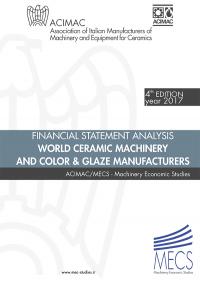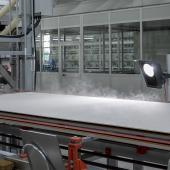Ceramic machineries: Italian companies see growth in profitability

Luca Baraldi, Acimac Research Dept ([email protected])
Salvatore Curatolo, Università di Parma
Now in its fourth edition, the new Acimac Research Department’s Report entitled “Financial statement analysis of world manufacturers of machinery for the ceramic and brick industries and glaze and colour producers” examines the 2013-2015 economic and financial figures of 213 companies operating in 14 different countries.
As for the tile, sanitaryware, tableware and heavy clay machinery segment (172 companies, including 138 operating in Italy), one of the key findings of the 2015 financial statement analysis is that the Italian industry continued its process of recovery with a further improvement in productivity, profitability and financial health. In particular, companies in this sector achieved significant growth in EBITDA (7.35% in 2015) and net profits (3.8% in 2015), while ROI rose to 5%, more than half a percentage point higher than the 2014 figure. But despite the improvements, the degree of capitalisation of companies is still insufficient, resulting in an excessive use of third-party capital as evidenced by an Equity Ratio of 24.7%.
Gross industrial productivity as measured by added value margin remained almost constant at 30%, although an improvement in inventory cycle efficiency was observed. Added value per employee reveals an increase in labour productivity due to optimisation of the use of labour and investments in more capital-intensive manufacturing technologies. This can be seen from the increase in invested capital per employee and the fall in unit labour costs (ULC) of more than one percentage point between 2014 and 2015 to reach 21% in Italy (compared to 26% for the non-Italian companies in the sample).
- The best levels of performance by company size
The study also reveals the characteristics of the best-performing companies in relation to company size. Out of all the 172 companies analysed at an international level, the best performances in 2015 were once again posted by medium-sized companies with turnovers of between 10 and 40 million euros. These companies are capable of fully exploiting economies of scale while avoiding the diseconomies of scale that typically affect large companies (including logistics problems, excessive fragmentation of responsibilities, inefficiencies in information flows and potential inefficiencies in the use of labour). This size class consists of 35 companies with excellent levels of profitability (23 based in Italy, 7 in other European countries, 2 in China, 2 in Japan and 1 in Brazil). The ratio EBITDA/turnover (9%) is higher than in all other size classes and average net profits stand at 5%.
- Best levels of performance by type of machinery produced
Another interesting analysis provided by the Acimac Report is that of the performance of the 172 companies in the sample in relation to the main type of machinery produced. In 2015 the best average management performances (showing a further strong improvement with respect to the previous year) were posted by companies that manufacture digital tile decorating machines (average EBITDA 10.31% and average net profits 6.87% of sales) and machinery for ceramic product finishing (EBITDA 9.77% and net profits 7.76%). Both categories display very high labour productivity, high investments per employee, low unit labour costs and a high level of gross and net profitability in relation to turnover.
The mould, press and kiln manufacturing segments posted performances in line with the sector average. The mould manufacturing segment stands out for its high added value (42.36% of turnover), although the extremely high efficiency of the production and procurement processes is offset by high unit labour costs (ULC). The press and kiln manufacturers are more successful at minimising the incidence of labour costs.
These results are confirmed by the Clustering and Benchmarking analysis (also included in the Acimac report), which shows that the largest concentration of producers of presses, finishing machinery and digital decoration machinery is in the highest-performing clusters AA, A and AB (Table 1). The results for mould manufacturers are less clear due to the relative inefficiency of the use of labour. Many companies are positioned in medium to low-performance clusters, although there are also cases of mould manufacturers in the highest-performing cluster (AA).
| Type of supplied machinery | Cluster AA - A - AB |
Cluster B - C - D |
|---|---|---|
| Raw Materials Preparation | 35.0% | 65.0% |
| Pressing | 66.7% | 33.3% |
| Moulds | 30.0% | 70.0% |
| Drying and Firing | 60.0% | 40.0% |
| Glazing and Decoration | 34.8% | 65.2% |
| Digital Decoration | 91.7% | 8.3% |
| Finishing | 70.6% | 29.4% |
| Total | 50.0% | 50.0% |
Did you find this article useful?
Join the CWW community to receive the most important news from the global ceramic industry every two weeks























